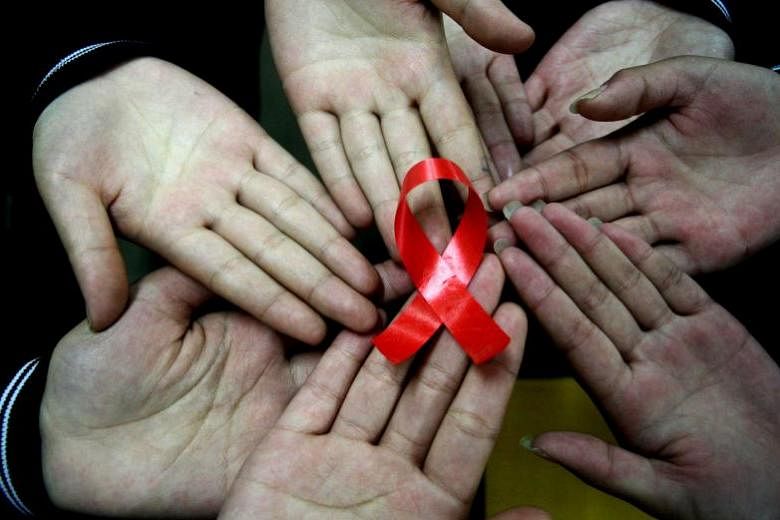PARIS (AFP) - Someone is infected with the Aids virus every 17 seconds in the world, and the disease has killed the equivalent of the population of Canada, figures released Thursday (July 20) by UNAids, or the Joint United Nations Programme on Aids, show.
Here is a snapshot of the acquired immune deficiency syndrome in key numbers and dates.
NUMBERS
17 seconds: Roughly 1.8 million people worldwide contracted the Aids virus in 2016. That figure breaks down to about one infection by the human immunodeficiency virus (HIV) that causes Aids every 17 seconds on average, or almost 5,000 per day.
Two-thirds of new cases in Africa: Since 2010, the rate of infection among adults has decreased slowly from 1.9 million then to 1.7 million per year in 2016. Two-thirds of new cases occur in Africa.
Children's cases cut almost by half: New infections among children have fallen sharply meanwhile and, since 2010, they have been cut almost by half, from 300,000 to 160,000 in 2016. A key factor has been detection among pregnant women in Africa, followed by treatment with anti-retroviral drugs that protect their baby.
Nearing 40 million with HIV: Today, close to 40 million people live with the virus. UNAids put their number last year at 36.7 million. The number continues to increase, however, owing to continued transmission and increased access to anti-retroviral drugs in developing countries that has raised the survival rate of HIV-positive people.
Deaths halved: Aids-related deaths have declined by almost 50 per cent since a peak of 1.9 million in 2005 to 1 million in 2016. Almost 20 million people now have access to effective treatment when followed regularly. An estimated 36 million people have died since the Aids epidemic erupted in 1981 according to the World Health Organisation (WHO), roughly equivalent to Canada's population.
DATES
From the start of the Aids epidemic in 1981, here are 10 dates in the history of the disease.
1981: First alert
On June 5, 1981, US epidemiologists report the first deaths among young homosexuals from a mysterious immune-wrecking disease later named acquired immune deficiency syndrome (Aids). The Centre for Disease Control (CDC) later identifies the same infections among injected drug-users (late 1981), haemophiliacs (mid 1982) and Haitian residents in the US (mid 1982). The term Aids appears in 1982.
1983: Identifying HIV
In January 1983, researchers in France, Francoise Barre-Sinoussi and Jean-Claude Chermann under the direction of Luc Montagnier, identify the virus that "might be" responsible for Aids. It is dubbed LAV. The next year, US specialist Robert Gallo is said to have found the "probable" cause of Aids, a retrovirus dubbed HTLV-III. The two viruses turn out to be one and the same and, in May 1986, it becomes officially known as the human immunodeficiency virus, or HIV.
1987: AZT
On March 20, 1987, the first anti-retroviral treatment known as AZT is authorised in the US. It is expensive and has many side effects, however.
1988: First Aids Day
Dec 1, 1988, is established by WHO as the first World Aids Day. In June 1989, the number of Aids cases worldwide is estimated at more than 150,000.
Early 1990s: Falling stars
US actor Rock Hudson is the first high-profile Aids victim in October 1985. In the early 1990s, other stars succumb to the disease, notably British singer Freddie Mercury in November 1991 and Russian dancer-choreographer Rudolf Nureyev in January 1993. The next year, Aids becomes the leading cause of death among US citizens aged 24 to 44.
1995/96: New approach
In 1995/96, a new approach begins with the advent of new anti-retroviral therapies, and drug combinations that provide the first effective treatment for HIV although they are not a cure. In the US, 1996 is the first year during which the number of Aids deaths declines.
1999: 50 million
A report released by WHO and UNAids in November 1999 estimates the number of people infected with HIV since it first appeared at 50 million, of whom 16 million died. Africa is the hardest-hit continent, with 12.2 million cases.
2001: Generic treatments
Following an accord signed in 2000 by UNAids and major pharmaceutical firms to make treatment affordable in poor countries, the World Trade Organisation hosts the signing of a compromise on Nov 13, 2001, that allows developing countries to produce generic treatments.
2008: Nobel Prize
On Oct 6, 2008, the Nobel Prize in Physiology or Medicine is awarded to Barre-Sinoussi and Montagnier "for their discovery of human immunodeficiency virus".
2012: Preventive treatment
On July 16, 2012, the anti-retroviral treatment Truvada is approved for use in the US as a preventive tool to help ward off HIV.


